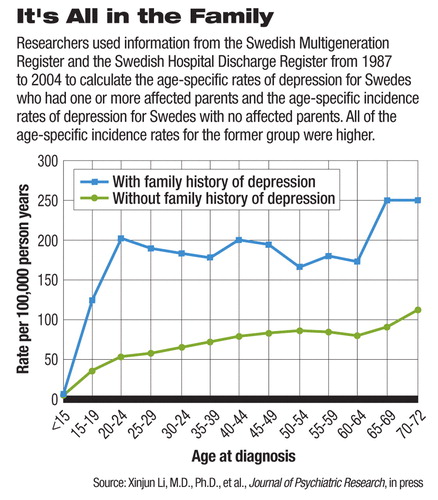National Registry Quantifies Family Depression Risk
Even during their Viking days, the Scandinavians tended to keep very good records. Keeping with that tradition, researchers in Sweden have harnessed various population databases to learn more about the familial transmission of depression.
Specifically, all men and women born in Sweden from 1932 on have been registered, together with their parents, in its Multigeneration Register. Moreover, the government started recording, as of 1987, complete data on all hospital discharges for depression in Sweden in the Swedish Hospital Discharge Register. So Xinjun Li, M.D., Ph.D., of the Karolinska Institute in Huddinge, Sweden, and coworkers used both the Multigeneration Register and Swedish Hospital Discharge Register data from 1987 to 2004 to determine which Swedes had been hospitalized for depression between 1987 and 2004, and which had one or more parents who had also been hospitalized for depression during the same period. They then used that information to calculate familial risks of depression during the period.

For example, if individuals had one affected parent, their chance of being hospitalized for depression as well was about three times greater than that of individuals with unaffected parents. When a male had two affected parents, his risk of being hospitalized for depression was five times greater than that of males with unaffected parents. When a female had two affected parents, her risk of being hospitalized was seven times greater than that of females with unaffected parents. But the greatest risks of all were noted for males and females aged 15 to 29 with two affected parents. The risk was eight times greater for males and 11 times greater for females.
Li and his coworkers also determined that depression risk in men with an affected mother was similar to that in men with an affected father, but that the risk in women with an affected mother was greater than the risk in women with an affected father.
Finally, the researchers compared age-specific incidence rates of depression in Swedes according to their parental history of depression. All age-specific incidence rates were higher in those who had one or more affected parents than they were in those with unaffected ones. And while the incidence rate of depression in Swedes with unaffected parents gradually increased with age, the incidence rate of depression in those with affected ones shot up between ages 15 and 20, took another small upward turn between ages 40 and 44, and rose even higher after age 60.
So all in all, there seems to be a strong familial impact on depression risk, and even on age-specific depression risk, Li and his team concluded in their study report, which is in press with the Journal of Psychiatric Research. Why this is the case is not clear, they admitted.
“It could be assumed that it is due to a genetic basis for depression. However, it is also possible that depression running in families is due to children learning depressive strategies from their parents.” Such strategies might be negative cognitions or dysfunctional behaviors, they speculated.
The study was funded by the National Institutes of Health, the Swedish Research Council, and the Swedish Council for Working Life and Social Research.
An abstract of “Age-Specific Familial Risks of Depression: A Nation-Wide Epidemiological Study From Sweden” can be accessed at<www.sciencedirect.com> by clicking on “J” under “Browse by Title,” then“ Journal of Psychiatric Research.” ▪



